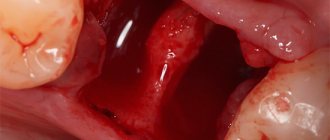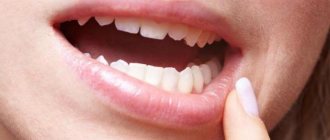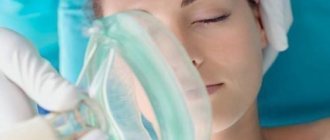How does socket healing occur?
The tissues are restored within approximately 10-15 days. At least by this point, the pain will go away, and external changes will no longer cause you concern. Of course, this is a conditional framework - the healing process for each patient occurs individually. Not only the injured gum is restored, but also the bone tissue inside the hole from which the root was extracted. Below we list approximate deadlines for all stages. If your symptoms are shorter/longer, there is no need to panic - you need to evaluate the remaining symptoms: when there are no additional manifestations of pathology, it means that rehabilitation is going according to plan.
- first 3 hours: after tooth extraction, bleeding occurs - this is a common situation, since the tissues have been injured. The hole is completely filled with blood, which normally immediately coagulates - this is how a blood clot or blood clot is formed. It is extremely important for normal rehabilitation! In fact, it is a natural barrier against the penetration of bacteria into the wound. The color of the hole is dark red,
- the first 2-3 days: the dark blood clot persists and thickens, its size decreases. Granulation tissue begins to form inside the hole - young connective tissue, which will become the basis for the restoration of the mucous membrane,
- 3-7 days: the clot brightens and acquires a whitish color. Granulation tissue covers almost the entire socket. Swelling and pain should decrease or even go away completely,
- 7-10 days: the blood clot dissolves, the remains can be seen only in the center of the hole, which has decreased in size. New bone tissue begins to form under the healing gum, which in 4-6 months will fill the defect from the edges to the center,
- after 15 days: young pink mucous membrane covers the entire socket, superficial healing is complete.
Normal healing – how long should it take?
If the tooth extraction was carried out efficiently and without medical errors, and the patient follows all the doctor’s recommendations, then the edges of the gums will be completely healed in a couple of weeks (sometimes 2.5 weeks). The soft tissues themselves around the hole heal in about 10 days. During this time, all sensations of pain, swelling, redness and discomfort should subside. Bone tissue, which replaces the tooth root and makes the jaw dense, forms in the socket up to 8 months. At this time, the person is no longer bothered by unpleasant symptoms, so the formation of young bone proceeds without problems. But if the tooth was pulled out traumatically and the surrounding tissues were torn, then healing of the gums will take a long time. The torn edges of a huge wound are usually located far apart from each other, the open hole gapes, exposing areas of bone and a septum between the roots. The socket and surrounding tissues become inflamed, and the formation of the epithelium is delayed for 1-2 months. Only after this does bone tissue begin to form, and a new gum cover forms above the hole.
After time, the hole heals, the edges of the wound are smoothed and tightened, and a new gum cover is formed.
In order for the gums to recover normally, not only a successful surgical operation during which the tooth was removed is important. It happens that a person has a tooth extracted due to some chronic illness, accompanied by mandatory medication. For example, if a patient is diabetic, or is forced to take blood thinners (or, on the contrary, has problems with clotting), then in such a patient the hole can behave completely unpredictably.
What to prepare for after removal: what is considered normal, and when to urgently see a doctor
In order to prevent the development of dangerous situations after tooth extraction, you need to notice alarming signs, and even if they are mild, consult a doctor in time - this way you will avoid serious complications. This may be alveolitis, fistula, nerve damage and other pathologies. They cannot be stopped or cured at home.
In the table, we have listed the symptoms and explained in which cases they should alert you, and when the situation remains within the normal range.
What to prepare for after removal
| Symptom | Norm | Threat: You need to see a doctor |
| The gums are painful and swollen, the cheek is swollen and blue | Swelling and hematomas (bruises) are a natural reaction to injury, especially if the removal was difficult. They can intensify for up to 3 days, and then begin to subside | Does not go away for more than 4 days, gets worse or appears after sleeping - a feeling that the cheek is “blowing” |
| The wound is bleeding | Bleeding stops within the first hour after surgery. Further minor and rare discharge is possible | If the blood flows heavily for several hours or bleeding starts again at home - it is the abundance of discharge that should alert you |
| Presence of a blood globule in the socket | A dark red clot begins to form immediately after removal, fills the entire hole, and persists for up to 5-7 days | The hole is empty, “dry”, deep, a yellowish-grayish coating has appeared, there is an unpleasant putrefactive smell - this situation is called a “dry hole” |
| A white coating appeared on the wound | A whitish film appears on days 2-3 - this is the release of fibrin (a protein involved in tissue healing) | Yellow, greenish or dark gray color, as well as bad odor, redness and pain indicate the development of an infection |
| Discharge from the socket | Ichor is a clear liquid that can ooze from the wound in the first day | Cloudy pus with a putrid odor indicates an infectious process |
| The temperature has risen | Within two days (usually in the late afternoon) body temperature can rise to 38-39⁰С | The fever is severe, the temperature stays above 38⁰C for more than 2 days in a row or rises again after the condition has returned to normal |
| It is impossible to open your mouth wide, there is jaw clicking | It mainly happens after the removal of large teeth – molars, wisdom teeth. Symptoms may persist for up to 3 days (for complex operations - up to 7 days), then gradually subside | Difficulty opening the mouth persists for longer than 4 days, there are no positive changes, the pain intensifies |
| Pain at the site of the extracted tooth | Aching or pulsating - may be on days 1-3, but fades away every day | Lasts longer than 3 days or intensifies every day, spreads across the face, extends to the ear, neck |
| Part of the gum and cheek are numb | Normal for several hours after surgery - anesthesia continues to work | If the tissues have lost sensitivity for more than a day, the nerves may have been affected. Need to see a doctor |
| Running nose | Not the norm! Pain when blowing your nose and breathing, liquid discharge and runny nose are a symptom of complications during surgery | |
Why does the socket (gums) sometimes take a long time to heal, and what does it depend on?
After the dental surgeon has removed the tooth from the socket, the wound healing process begins by so-called secondary intention. This means that the circular ligament around the tooth contracts and the edges of the gums move closer together. The formation of a blood clot in the socket has a very beneficial effect on the wound healing process after tooth extraction - this clot plays an important role as a kind of protection against possible infection. Accordingly, in no case should this clot be removed, for example, by intensive rinsing of the mouth or, especially, mechanically - with a finger or a toothpick.
The blood clot is replaced by granulation tissue within a few days, and then osteoid tissue is formed. In other words, over time, a new bone with gum formed above it forms in place of the removed tooth.
In case of traumatic tooth extraction, when the gums rupture and a significant part of the walls of the socket is damaged, the healing process can be very prolonged, and how long it takes for tissue restoration will depend on a number of factors.
The first of these factors is the condition of the wound immediately after the procedure: the more mistakes the doctor made, the worse the gums always heal.
Review
Two weeks ago I removed the roots of the last lower right tooth, a seven I think. At first, the removal went well: they made two injections into the gums: outside and inside, then the surgeon began to grab my painful tooth with forceps, but it broke off, and its pieces flew off onto my tongue.
After I spat, some nonsense began: the doctor took a chisel and a hammer and began to chisel along with the nurse on my tooth, as I understood - to divide the roots in half. It didn’t hurt, but it was terribly creepy, there were blows in my head, and the vibration created an unpleasant sensation. As soon as the roots crunched, the surgeon began to remove them with some sharp metal rods. It didn’t hurt, but a lot of blood came out because they were picking at the gum for about 30 minutes.
After extracting two roots in turn, the doctor put a piece of gauze in my mouth, let me squeeze it for 20 minutes and sent me home. When I came home, in the mirror I saw in the place of my former tooth a loose gum, both inside and outside, and my tongue was touching the edge of the bone, which was not covered by anything. Within an hour, the gums became very sore and began to bleed.
The laceration continued to hurt for more than 3 days, and even when it went away, the sharp edge of the bone still greatly interfered with my chewing. As a result, the hole at the site of the extracted tooth took a month and a half to heal, so I had to constantly rinse out any remaining food from it. I will never go to such a doctor again.
Ivan, Armavir
The second factor that determines the wound healing time is the possible addition of infection.
Infection of the socket often occurs during a complex extraction, when the carious remains of the diseased tooth are thrown deep into the wound, which causes it to fester. In most cases, after such a tooth extraction, the gums and socket take a very long time to heal.
However, it is important to note the fact that a purulent process in the hole can also occur as a result of poor wound care on the part of the patient himself: in this case, the infection occurs not during the removal procedure, but after it. When food constantly gets into the hole and accumulates there for a long time along with bacteria from the oral cavity, the wound can fester and its healing is significantly delayed.
It is also useful to read: Interesting details of wisdom teeth removal in the upper jaw
How to ensure that there are no complications after tooth extraction?
At the first stage, you need to choose a doctor who will carry out professional and careful removal without severe tissue injury. It is important that the operation is performed not by a dental therapist, but by a dental surgeon or even a maxillofacial surgeon - an implantologist. It is a highly specialized doctor who knows how important it is to preserve the volume of bone tissue so that after this operation there are as few restrictions as possible for implantation.
The most important thing after the operation itself is to strictly adhere to the instructions and recommendations given by the doctor. If medications are prescribed, they must be taken for a strictly prescribed time. See our short checklist of what you can and cannot do after surgery, as well as detailed recommendations that will help you shorten the rehabilitation period and go through it without pain and complications.
Medicines
- Most often, after the removal of a wisdom tooth, the gums hurt. If the pain is too severe and causes significant inconvenience, it is permissible to use an analgesic or stronger drugs, such as Ketanov.
Ketanov - In some cases, your dentist may prescribe an antibiotic to prevent an infection from developing. You need to drink it exactly as the doctor says. Otherwise, you can only harm the body.
- If you have a fever, you can take Ibuprofen or paracetamol. If the increase occurs again, you should consult a doctor.
Ibuprofen
If your throat hurts after wisdom tooth removal, it is quite possible that the infection has spread to your tonsils. In this case, it is also worth visiting a therapist.
A short checklist: a list of recommendations after tooth extraction
What can and should be done
- hold the cotton swab applied by the doctor for 20-30 minutes,
- within 2-3 hours after surgery, be sure to apply cold compresses to reduce tissue swelling,
- carry out oral baths (not to be confused with rinsing) with antiseptic drugs for 3-5 days: “Miramistin”, “Chlorhexidine 0.5%” or other drugs prescribed by a doctor can be used as medicinal solutions,
- after 3-5 days, start using a toothbrush - only a soft one for the operated area, as well as a new one, without bacteria on it. The teeth of the opposite jaw can be brushed immediately, the main thing is to avoid the area of the extracted tooth,
- chew food on the side opposite the injured area,
- You can drink water immediately, preferably warm water,
- You can eat only after the anesthesia wears off, that is, after 2-3 hours,
- Lead a quiet lifestyle, try to avoid physical activity and heavy lifting for 5-7 days.
What you should absolutely not do
- don't rinse your mouth! Mouth baths in the first 3-5 days are more than enough,
- do not use hot compresses! This is fraught with the appearance of edema and the development of inflammation,
- do not create a vacuum in your mouth: do not puff out your cheeks, sneeze, blow your nose and spit very carefully,
- do not pick the wound, do not touch the clot with your tongue,
- do not drink or eat hot or cold food, only warm food,
- try to quit smoking for at least 2-3 days after surgery,
- Do not drink alcohol for 2-3 days - it does not promote tissue repair. Also exclude it if the doctor has prescribed a course of antibiotics,
- Do not overcool or overheat - give up sports exercises, swimming pools, saunas for 5-7 days.
What can be dangerous about prolonged gum healing after tooth extraction?
As a result of infection joining the wound, alveolitis may occur - inflammation of the hole after tooth extraction, which usually develops already 1-3 days after the procedure. In this case, acute pain occurs in the area of the extracted tooth, normal healing of the socket is disrupted (an unpleasant putrid odor from the mouth is often also observed).
The result of the purulent inflammatory process is long-term healing of the gums, which, moreover, determines the risk of developing a serious complication - limited osteomyelitis of the jaw.
Of particular danger is prolonged healing of the gums due to the addition of infection after the removal of the lower wisdom tooth. Since the lower wisdom teeth are surrounded by soft tissues that have an abundant blood supply, the entry of bacteria into the wound after a simple or, even more so, complex removal can lead to serious consequences, including the spread of infection deep into the tissue. Infection of the jaw and peri-maxillary areas against the background of reduced immunity can lead to life-threatening abscesses and phlegmon.
The extreme expression of these complications is sepsis - infection of the blood with pathogenic microbial flora, which may well lead to death.
The most complete reminder for patients after tooth extraction
So, you left the doctor's office - the surgeon asked you to tightly squeeze a gauze pad with your teeth, which will help stop the bleeding. You need to hold it for about 20-30 minutes, that is, while you fill out the necessary documents at the clinic or go home. Remove the tampon carefully, moving it slightly to the side, without sudden movements, so as not to damage the fresh blood clot.
Very important! A thrombus (usually called a “blood clot”) protects the wound from microbes and prevents pieces of food and saliva from accumulating in the hole during the first week of rehabilitation. This is a natural sterile dressing that starts the process of new tissue formation. The most important rule that will protect you from complications and severe inflammation of the wound is to never remove the clot, do not touch it with your tongue or fingers, do not touch it with a toothbrush and protect it from other influences. Gradually it will resolve on its own.
Do not keep the tampon in place for more than 30 minutes - gauze soaked in blood and saliva will quickly become a breeding ground for infection. In addition, a blood clot is forming in the hole - the presence of a foreign body and additional injury are of no use to it. You need to give the wound the opportunity to heal naturally.
“If you have a complex tooth extraction, especially if you had surgery to remove wisdom teeth, or if you have an underlying condition, such as diabetes, you may need to observe a doctor for a few more hours. For this purpose, we have our own hospital, where you can sit comfortably and relax while we monitor your condition to see if there are any complications. This will give us confidence that the operation will be successful and will reassure you as the patient.”
Kopylov Ivan Pavlovich, maxillofacial surgeon, implantologist, more than 14 years of experience make an appointment
Tooth extraction WITHOUT complications! The modern equipment of our clinic allows us to carry out the most accurate and comprehensive diagnostics. Consultation is free!
Sign up online
Swelling after tooth extraction (especially if it was complicated) can be prevented by applying a cold compress - to do this, wrap an ice pack from the freezer in a towel and apply it to the cheek (that is, from the outside) for no more than 20 minutes. After 15 minutes the procedure can be repeated. If you don't have ice on hand, frozen vegetables or meat will do, but be sure to wrap them in a bag and a towel to avoid cold burns. Cold constricts blood vessels, reduces pain and swelling, although it does not completely remove swelling. Compresses are effective immediately after surgery for approximately 3-4 hours.
Do not warm up the injury site under any circumstances! A hot compress will only make the swelling worse by increasing blood flow to the area of inflammation. This will lead to serious complications after surgery.
Symptoms after removal
Considering the anatomical features of these teeth, the practice of removing them is often associated with such unpleasant moments as injury, infection, suppuration, etc. The agents used for anesthesia do not always have the necessary effectiveness. Therefore, you should not be surprised if, for example, your cheek is swollen after the removal of a wisdom tooth. There is an almost 100% chance that the gums will be significantly damaged, resulting in the swelling that is standard with such injuries.
Swelling of the cheek after tooth extraction
At the same time, it is painful for a person not only to eat, but also to simply open his mouth. If food gets into the hole, the pain intensifies. Under normal conditions, such symptoms only last a few days. But not everyone is so lucky. It is not at all uncommon when the pain does not subside, the swelling of the cheek increases, and then the body temperature rises to 38-38.5 degrees.
Don't panic, but don't launch either. Because we don't know what's going on. In any case, you need to see a dentist.
Doctors are people too and can make mistakes in their work. For a surgeon, such a mistake can lead to the death of the patient; for a dentist, it is usually less tragic. In addition, teeth often grow in such a way that it is impossible to do without sacrifices.
Wisdom tooth removal
My friend had a similar situation. My wisdom tooth hurt. He went to delete it. They took a picture and said that the root was growing very awkwardly. They pulled it out, as they say, with a creak. They damaged a neighboring tooth and eroded the gum. He suffered more with the consequences than with the tooth itself. Moreover, he followed all the doctor’s advice, because the man is very disciplined and responsible. How many people think that all these recommendations are nonsense?
If you have a fever after wisdom tooth removal, go to the doctor immediately. If suppuration begins, you need to urgently take action before something more serious happens.
Gum festering after tooth extraction
Under no circumstances should you heat the hole yourself. On this subject, I will tell you another interesting story from my life. Another old one of mine decided (on the advice of his father) to warm up the hole using a UHF device, which the father of the family wrote off at work in Soviet times. The result was not long in coming. The gums became swollen and then began to swell. I had to cut it. Therefore, it is better not to pretend to be a doctor, but to listen to what the dentist advises, so as not to eliminate the consequences of your initiative later.
Video - Consequences of wisdom tooth removal
When can you eat and drink after surgery?
You should not strictly limit yourself in nutrition, you will need strength to recover - you can eat as soon as the anesthesia wears off, namely after 2-3 hours. You can drink it immediately after you remove the cotton swab. Until this point, it is undesirable for food particles or bacteria to get into the open hole.
In the first 3-5 days, you need to take into account several nuances in nutrition so that further healing of the wound goes well:
- food should be warm. Hot or cold food will irritate tissues and cause blood vessels to dilate or constrict, which can cause new bleeding,
- It is better to exclude rough food to avoid mechanical damage to the wound. Soups, purees, baked and boiled foods, minced meat dishes,
- Do not chew food on the side where the tooth was removed to keep the protective clot intact.
Carefully! Many people mistakenly believe that in the first days it is better to drink and eat liquid foods through a straw. But in fact, suction creates a vacuum in the mouth, which can displace the clot or disrupt its integrity. Should not be doing that. For the same reason, you should not spit or suck in your cheeks.
After what time can I eat?
Quite a common question in dental practice. You can eat within two hours after surgery. However, it is strictly not recommended to chew on the side of the extracted tooth. Especially dense and tough foods. This applies to the first few days after the procedure.
You can drink plain water 20-25 minutes after surgery. There are no food restrictions. It is desirable, of course, that in the first two days it should be as gentle and soft as possible. Yogurt, sour cream and other similar products are perfect.
How to do oral hygiene
The main task is to preserve the blood clot on the wound of the extracted tooth, while maintaining cleanliness and health in the mouth. How to properly care for your teeth during this period:
- There is no need to carry out any hygiene procedures immediately after tooth extraction. It is better to postpone the first brushing of your teeth until the next morning. You will need a brush with soft bristles. And it’s better to take a new one so that it is sterile. You need to brush your teeth with a small amount of paste, avoiding the wound area, and clean adjacent teeth with caution.
- Do not rinse your mouth (including after brushing your teeth) or use an irrigator in the first three days! The clot may dissolve or be washed away with the flow of fluid, and treatment will have to be restarted. Instead of rinsing, make mouth baths - just take water into your mouth and carefully spit it out. If the doctor prescribes antiseptic drugs, rinse with them,
- try not to touch the open wound with your tongue, hands or toothpick - this can damage or dislodge the clot and introduce an infection into the hole.
You can’t neglect hygiene - bacterial plaque will accumulate in your mouth, which can cause inflammation.
Complications
Normally, pain and swelling should gradually subside within three days. In this case, in the evening the temperature may rise slightly - 37˚. But if symptoms continue to increase rapidly, you should consult a doctor. This is necessary in the following cases:
- Bleeding.
- Fever.
- Edema.
- Suppuration.
- Acute pain.
How should you care for an extracted tooth if a complication occurs? In case of prolonged blood loss, you need to close the hole with a gauze swab and bite for 10 minutes. The bandage should be changed periodically.
During surgery, anesthetics containing adrenaline are sometimes used, which may result in almost no blood immediately. Bleeding develops after the anesthesia wears off. Another hemostatic agent is a hemostatic sponge. It is placed in the hole and covered with a piece of bandage. Taking the drugs Vikasol or Ditsion will also help. In case of prolonged blood loss (longer than 24 hours), dizziness, nausea, loss of consciousness, consult a dentist or call an ambulance.
To reduce swelling, apply cold to the cheek for 5 minutes, several times. This remedy is effective only on the first day after surgery.
To relieve pain, you can take Nurofen, Ketanov, Nise. To bring down the temperature - Rapidol, Paracetamol.
How should you care for an extracted tooth with purulent inflammation? Suppuration of the walls of the socket can form as a result of the loss of a blood clot, the presence of bone fragments in the wound, weak immunity, or non-compliance with doctor’s recommendations. This condition requires urgent treatment from a dentist, otherwise the pus can spread to the bone tissue of the jaw, facial muscles and internal organs. It is not possible to cope with the disease at home; careful treatment of the hole is required, removal of purulent masses and food debris, and the use of a special drug.
Medicines after tooth extraction: what to take at home
To prevent complications, your doctor will prescribe home remedies for you. Which medications you can take depends on your specific situation, body characteristics, allergic reactions and possible concomitant diseases.
How to reduce pain after tooth extraction
Your doctor will recommend the medications to you. You should take painkillers as needed - at night or when the anesthesia wears off. If the pain becomes severe in the first days, you can take analgesics prescribed by your doctor every 4-6 hours, but no more than 4 days in a row.
Important! Do not take aspirin or other blood thinners.
What antibiotics should you take?
Antibacterial drugs are needed if the immune system itself cannot cope with pathogenic microbes, and infectious inflammation begins. But antibiotics suppress the activity of “good” microorganisms and also have many side effects. Therefore, they are prescribed strictly based on health conditions at the time of tooth extraction and how the operation went. As a rule, they are necessary if there is concomitant inflammation in the oral cavity, an infectious process in the acute stage in the body as a whole, or if a large number of teeth were removed at once.
When receiving a further treatment plan, you need to purchase medications immediately, without delay, so that you can help yourself in case of increased pain and discomfort. The doctor’s recommendations must be strictly followed, avoiding “amateur activities.”
Therapeutic oral baths during tissue restoration
Intense rinsing is prohibited - this way the solution can wash out the blood clot and expose the socket, causing the tissue to become inflamed and difficult to heal. Rinses are replaced with medicinal baths. For this, both plain water and antiseptics prescribed by the attending physician are suitable: a solution of “Chlorhexidine” 0.05% (in this concentration it is sold in a pharmacy) or “Miramistin” you just need to hold it in your mouth for about 30-60 seconds, and then spit it out. You need to repeat the procedure after meals, 3 times a day.
Such baths will become a mandatory component of the prevention of inflammation if you have the following problems in the oral cavity:
- other teeth are damaged by caries or have tartar on them. Pathogenic microorganisms in sediments can lead to the development of alveolitis,
- cuts were made on the gums to expose the gumboil,
- under the extracted tooth or the tissue nearby was inflamed.
Rehabilitation without complications! We use modern equipment and materials to ensure that even complex tooth extractions are carried out with minimal trauma.
Enroll now
How to speed up the gum healing process after tooth extraction
To understand how you can effectively accelerate gum healing after tooth extraction, you should remember the conditions for normal healing of living tissue in general.
It is also useful to read: How to stop bleeding after tooth extraction
The most favorable option for wound healing is to create the most sterile conditions possible. Naturally, the concept of “sterile” is only very conditional here, since the destruction of all bacteria (both beneficial and harmful) can lead to negative consequences, for example, dysbiosis in the oral cavity, which affects the general health of a person. In order not to cause harm to health, but to ensure comfortable and short healing for the hole after tooth extraction, both general and local methods can be used to prevent secondary infection.
There are certain rules, the implementation of which will allow the gums to begin to recover successfully within the next few hours after the tooth extraction procedure:
- Hold tightly with your teeth the gauze swab placed by the doctor on the hole after removal. It is the pressure on the edges of the wound that is important, and not the time, although the average holding period is regulated and is 15-20 minutes.
- You should not eat food for 3 hours, and it is advisable not to drink, so as not to disrupt the process of formation of a blood clot in the socket.
- You should not smoke or drink alcoholic beverages, spicy, hot or solid foods in the first days after removal. Following this simple rule will protect the “blood plug” from injury, and the socket from repeated bleeding and purulent inflammation.
- You cannot engage in heavy physical labor, sports, go to the bathhouse, sauna, sunbathe and overheat for several days (for the same reasons).
- If possible, avoid chewing or sleeping on the same side of the jaw where the tooth was removed for two days.
To speed up the healing process of the gums after tooth extraction, you can also use local methods of caring for the hole. The most popular among the options used are rinses, although a number of doctors warn about possible harm to the blood clot. The fact is that some patients mistakenly start rinsing with anything: soda, salt, vodka, vinegar, hydrogen peroxide, etc. Who is much more than that.
Sometimes such methods do not cause harm only by luck, but most often the wound is irritated and the blood clot is destroyed, which not only does not speed up the gum healing process, but also significantly lengthens it, bringing additional pain and suffering to the adherent of such folk methods. It also happens that such mockery of one’s own health leads a person straight to the operating table.
Generally speaking, even rinses with infusions, herbal decoctions and pharmaceutical solutions approved by most dentists cause a lot of controversy regarding the start of rinsing, frequency and duration. Dental surgeons have their own opinion on this matter, since if you prescribe rinsing from the first day of tooth extraction (mainly after eating), this will prevent the accumulation of food debris in the wound and its rotting, but can lead to the separation of a blood clot during intensive “ gurgling" in the mouth of a decoction of the same chamomile or sage.
Based on the position of common sense, you can use herbal decoctions (chamomile, sage), pharmaceuticals (a weak solution of furatsilin and chlorhexidine), after consulting with a doctor, and use them only after meals, very carefully and without fanaticism, especially in the first two days after tooth extraction, so that the healing of the hole is comfortable.
Dentist's opinion
My position regarding home rinsing with solutions after tooth extraction to speed up gum healing is simple and understandable to everyone, as it has logic and scientific justification. On the first day after removal, you should not use rinses, but limit yourself to oral baths. That is, it is not recommended to rinse your mouth, but rather hold the antiseptic in your mouth and spit, and repeat this for 2-3 minutes, at least 6-8 times a day.
In my practice, I do not prescribe furatsilin, because, firstly, it still needs to be diluted to the required concentration so as not to cause irritation in the oral cavity, and, secondly, it dries out the mucous membrane greatly.
Decoctions of chamomile and sage are excellent for mouth baths on the first day of tooth extraction, and subsequently for rinsing after each meal. However, this is an excellent budget option, and modern means for preventing socket suppuration are antibacterial drugs, ointments, and gels for topical use.
Dental surgeon, Oleg, Moscow
For topical use in order to accelerate gum healing after tooth extraction, a dental surgeon may prescribe Solcoseryl dental adhesive paste, Metrogyl Denta gel or other drugs.
In case of difficult removal of a wisdom tooth, in case of tooth extraction due to serious purulent odontogenic processes in the surrounding tissues and jaw bone, as well as in weakened patients, additional antibacterial therapy is prescribed, most often with antibiotic drugs, as they reduce the microbial load in and around the wound , as a result of which the gums take less time to heal.
Useful video about alveolitis - a serious complication that sometimes occurs after tooth extraction
General recommendations after surgery
On the first or second day after tooth extraction, you want to lie down and sleep - this is the body’s natural reaction to the stress experienced. After the release of stress hormones - adrenaline and cortisol - stabilization and rest are needed. Don't deny yourself this.
However, there are recommendations regarding sleep: you should raise the pillow higher and sleep reclining so that your head is elevated. This will prevent unnecessary pressure on the jaw and cause bleeding. To increase the inclination of the bed, place a pillow under the mattress or use two pillows.
Otherwise, maintain a calm regime without physical overload, pressure surges and overheating. That is, for the first time it is better to refuse air travel, hard work, playing sports and lifting weights, visiting the pool, bathhouse or sauna. You should not take a hot bath (a short warm shower would be preferable) and stay in the sun for a long time or sunbathe in a solarium. All this increases blood pressure, which is fraught with new bleeding. It is ideal if you have a couple of days off to recover after your teeth are removed.
If there is an infection in the hole
Gum healing usually proceeds well. If no mistakes were made on the part of the dentist, and the gums are not too “disrupted”, the natural properties of the body will do their job, and all unpleasant symptoms will soon disappear. But sometimes an infection gets into the hole, and the patient’s careless behavior is not always to blame. It happens that infection cannot be predicted - it occurs accidentally when the carious remains of a destroyed tooth get into the wound. Such a hole immediately suppurates and often takes a very long and painful time to heal.
After tooth extraction, the injured socket is filled with a blood clot; this accumulation of blood is a barrier to bacteria, thereby accelerating the healing of the gums.
The mouth is considered the most polluted place in the human body, where a huge number of microorganisms constantly live. When a bleeding hole also appears in this environment, the number of bacteria increases noticeably. The ideal source of nutrition is not only the blood oozing from the wound, but also food debris that can be difficult to remove from the hole. Therefore, gum healing is usually associated with careful oral hygiene and high-quality care for the socket during its tightening. The patient must understand that the infection can come from absolutely any external source: touching the lips with dirty hands, using an old toothbrush, drinking from a bottle with an untreated neck. If a fresh wound becomes infected, the healing of the gums will take place very slowly - up to several months.
Frequently asked questions after tooth extraction
In this section, we answered the most popular questions that arise in the first days after tooth extraction.
How long will the wound bleed after tooth extraction?
The appearance of blood after removing a tooth from the socket is a normal phenomenon, since the periodontal tissues are penetrated by many capillaries and vessels.
When they are injured, even minimally, the hole fills with blood necessary for the formation of a blood clot. Normally, this occurs within 20-30 minutes and depends on the individual characteristics of blood clotting. Minor, very light bleeding may occur for another 2-3 days after surgery. It is important to distinguish blood from ichor - a clear liquid, slightly yellowish in color. Due to the small amount of blood, it can sometimes be pinkish. Ichor can normally be released from the socket within 12-14 hours after tooth extraction.
But if, 3-5 hours after the operation, the bleeding not only does not decrease, but also intensifies, you need to consult a doctor.
I removed the tampon from the wound 20 minutes after the operation, but the wound is still healing. What to do?
If the wound is still bleeding a little after removing the compress, you can apply another swab of sterile gauze (available at the pharmacy). It is lightly moistened with boiled water or chlorhexidine, applied to the wound and the jaws are squeezed tightly. Also, do not keep the new tampon in place for more than 20 minutes, so as not to provoke the development of infection.
Blood flows for more than 3 hours. This is fine?
You should immediately consult a doctor in the following situations:
- bleeding does not subside in the first 30 minutes and continues for several hours or even days,
- secondary bleeding: in the dentist’s office the hole stabilized, and when you returned home, the bleeding started again, and quite profusely and for a long time.
The reasons are different: taking certain medications (for example, blood thinners or hormonal drugs), menstruation in women, hypertension, diabetes mellitus, abnormalities in blood clotting and other blood diseases, drinking alcohol on the eve of extraction, as well as violating the dentist’s recommendations. Therefore, it is important to inform your doctor in advance about your existing diseases and medications, so that the doctor can prevent an unfavorable outcome.
When will my stitches be removed after surgery?
The wound is stitched for a more reliable connection of the alveolar walls and faster healing. You usually do not need to have your stitches removed by a doctor. We use special surgical threads that dissolve after 7-10 days and eliminate the need to return to this issue. If nothing bothers you and the stitches look healthy, then you don’t need to see a doctor.
Why didn’t the surgeon stitch up my wound after the tooth extraction?
The doctor always evaluates how the situation is developing - how extensive the intervention was, whether the gum had to be cut, how many roots the tooth has, how quickly the blood clots. If the wound is small and the prerequisites for healing are normal, then stitches are not necessary.
Is it possible to drink alcoholic beverages after tooth extraction?
We understand that amid the stress experienced, for some, a natural impulse is to relax with the help of alcohol, especially if the tooth extraction was difficult. But the answer is clear - no. Alcoholic beverages should not be consumed 24-48 hours before removal and for at least 2-3 days after surgery. Due to the dilation of blood vessels under the influence of alcohol, bleeding will open again in the hole, and a hematoma may appear on the mucous membrane. And if you have been prescribed antibiotics, then combining alcohol with them is dangerous, and alcohol is contraindicated until you finish taking the medication.
Is it possible to smoke regular cigarettes? What about electronic cigarettes, hookah and vaping?
Smoking in the first 2-3 days after tooth extraction has an adverse effect on the condition of the wound. Nicotine causes a sharp contraction of blood vessels, and the tars and chemical compounds that make up cigarettes irritate the mucous membrane and slow down healing. If stitches were placed, we do not recommend smoking for 2-10 days after tooth extraction.
Hookah mixtures contain glycerin, which causes tissue dehydration. E-cigarette formulations use propylene glycol, which is converted into toxic compounds that inhibit nerve impulses. Many people believe that vaping is safer than regular cigarettes, but there is still an additional chemical load on the wound. So the restrictions on hookah, vaping and electronic cigarettes are exactly the same as on tobacco - try not to smoke for several days after tooth extraction.
It has been proven that the risk of alveolitis - an infectious inflammation of the tooth socket - increases by 40% if the patient smoked immediately before tooth extraction1.
After a tooth was removed, caries was discovered on the adjacent one. Can it be cured immediately?
It is better to postpone treatment of other teeth or professional hygiene after tooth extraction for two to three weeks, unless otherwise indicated by a doctor. The fact is that when drilling a carious cavity or cleaning deposits, pathogenic microflora can enter the wound and cause its inflammation. But in some cases, when treatment is absolutely necessary, an experienced doctor will take measures to protect the socket using special membranes and protective devices.
I have problems with blood pressure. Is it possible to have surgery?
If you have problems with blood pressure, you need to monitor it regularly. Before tooth extraction and during the recovery period, you will need to take additional medications prescribed by your doctor in order to normalize your condition and indicators.
I have diabetes, but they recommended that I have a tooth removed. Is it dangerous?
If you have been diagnosed with diabetes, you probably have a blood sugar monitor. It is important to maintain normal indicators and take into account additional rules:
- Tooth extraction is possible at the stage of disease compensation, when sugar levels are stable for several months. In the decompensated stage, elective operations are not performed due to the risk of bleeding and the body’s reaction to anesthesia,
- you should go for an operation to remove teeth in the morning,
- Immediately before tooth extraction, it is better to administer an increased dose of insulin to prevent a spike in sugar.
Due to stress before surgery, sugar levels may increase, so it is better to consult with an endocrinologist in advance about which drug to take to avoid a sharp jump in blood sugar. You also need to know that rehabilitation after tooth extraction in patients with diabetes mellitus is slower.
How long should I use a soft brush after surgery?
After the wound has healed, that is, after 2-3 weeks, you need to return to a regular brush of medium hardness - a soft toothbrush copes worse with plaque, and if there are no open wounds in the mouth, there is no need for it.
After the operation, the skin on my lips became dry and cracked, and herpes developed. What's the matter?
Dry lips occur due to a long stay in the dentist's chair (if many teeth were removed or the procedure was complex). Herpes can worsen due to decreased immunity (usually due to an acute stressful situation).
Smile without embarrassment and without “holes” in the row! More than 30 implantation solutions. Restoring your teeth immediately after extraction in just 1 day! Get started with a free consultation.
Enroll now
Possible complications after removal
The first problem that arises due to improper treatment or violation of the dentist’s recommendations is alveolitis. It is an inflammation that occurs inside the socket of an extracted tooth.
Alveolitis due to tooth extraction
In some cases, the process is accompanied by suppuration, necrotic tissue appears, and the temperature may rise.
The cause may be the accidental displacement of a blood clot. However, it is not always random. Often patients touch the hole with their tongue, immediately begin to rinse their mouth and actively brush their teeth. Their actions lead to the washing out of the clot. After some time, bad breath, pain, and inflammation appear. If alveolitis is not treated, then the periosteum is affected, and there may be complications in the form of abscesses and phlegmon.
Among the symptoms of alveolitis after wisdom tooth removal, the following are worth highlighting:
- loss of strength, general fatigue;
- increase in body temperature to 37 - 38.5 degrees;
- inflammation of the submandibular lymph nodes;
- the appearance of bad breath;
- specific bitter taste;
- pain. It can spread to the ear, temple, and neighboring teeth.
In the photo there is alveolitis of the tooth
Self-treatment of the disease is not provided. It must be carried out by a dentist, using special preparations, removing pus and necrotic tissue.
How long can gums hurt after wisdom tooth removal? Under normal conditions and with minimal trauma during surgery, the pain goes away after two to three days. If the gum had to be cut or it was significantly injured, with swelling and inflammation, the discomfort may persist much longer. You will be able to completely forget about what happened in one and a half to two weeks, and even then if there are no complications.
4 painkillers after tooth extraction:
| Rating | Name | Photo | Analogs |
| Ketanov | Ketorol | ||
| Nimesil | Nurofen, Ibuprofen, Diclofenac, Nise, Affida Fort | ||
| Analgin | Baralgin, Spazmalgon, Tempalgin, Antipirin | ||
| Movalis | Meloxam, Xefocam, Amelotex, Diclofenac |
If the pain persists longer than can be explained by natural causes, there is no need to drown it out with pills. It is important to find out the cause of this unpleasant phenomenon.
Sometimes during the removal process, a tooth fragment or a piece of root may remain in the hole. This leads to an inflammatory process. The doctor needs to eliminate the error and treat the hole with antiseptics. In some cases, it is necessary to prescribe additional treatment to protect the patient from spreading the infection. These can be complex techniques that combine the use of topical medications and taking pills.
After tooth extraction, a fragment remains
The appearance of edema is sometimes associated with a specific reaction of the body. This is an allergy to a drug used as an anesthetic. Many people experience a similar effect. A large percentage of dental patients are allergic to lidocaine. Therefore, other drugs are used for them to avoid side effects.
As for bleeding, it goes away quickly. Except in cases of poor blood clotting. It can be caused by the use of acetylsalicylic acid, Heparin drugs and other blood-thinning agents. If you have clotting problems or use similar medications, you should tell your dentist right away. His arsenal includes specialized hemostatic agents that will help resolve the issue without unpleasant complications.
At the dentist
The cause of the inflammatory process may be a cyst that was not detected either before the removal of the wisdom tooth or after the operation. It is a source of infection in the hole and poses a danger to the body as a whole. It is important to detect it in a timely manner and remove it before the infection enters the surrounding tissues and blood.
Another unpleasant complication involves nerve damage. It's called paresthesia. The patient feels numbness in the chin, lips, and tongue. In most cases, these symptoms go away within a couple of weeks. But it happens that this effect persists. Fortunately, the second option is rare.
Unfortunately, sometimes paresthesia after tooth extraction persists forever
The most common question asked by dental patients is when can you eat and drink after wisdom tooth removal? Official medicine says that in 2-3 hours. But here the question is very individual. For some people, it's better to wait a little longer. Also, avoid rough, hot and spicy foods to avoid complications. You should also not chew on the side where the tooth was pulled out.
I wish you good health and may you never be bothered by toothache. If you happen to have wisdom teeth removed, my advice to you is not to neglect the doctor’s advice, then you won’t have to treat unpleasant and painful consequences.
Consequences of tooth loss: what happens to the bone and how to preserve it?
Even if only one tooth is removed, the situation with the jaw in this place immediately begins to deteriorate - the bone no longer receives the chewing load, metabolism stops in it, and the area of bone tissue under the tooth begins to sag, that is, atrophy.
This is a rapid process - bone loss can reach 30% in the first year alone. Subsequently, it will be problematic to place an artificial tooth supported on an implant in this place, both due to the constant subsidence of the bone and gums, and due to the displacement of neighboring teeth. They lose support, so they shift and tilt into the resulting “emptiness” - this is how problems with bite develop.
To prevent bone atrophy, especially during complex extractions of multi-rooted teeth, it is recommended to install a bioframework or replant a biocompatible artificial bone material with the application of a membrane. Thus, the bone volume and height of the alveolar ridge are maintained sufficient for future unhindered dental implantation.











